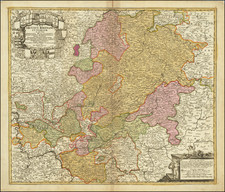Trier in the 18th Century
Published by Seutter in about 1740, the map of the ancient city of Trier offers a rich depiction of this historically significant metropolis nestled by the Moselle River. Illustrated in fine old color, the map provides both a strategic plan and a picturesque view of Trier, evoking not only its contemporary relevance but also its ancient roots.
The fortified walls stand out prominently, delineating the boundary of the city and attesting to its strategic importance in earlier times. The map is especially detailed, noting several significant buildings both within and outside these protective barriers
The map is flanked by the coat of arms of the city, and interestingly, an emblematic representation of either Saint Maxime or Saint Wendelin of Trier two patron saint of the region. An accompanying view from across the Moselle River further accentuates the city's strategic position and its scenic beauty. This view is adorned by two allegorical scenes, adding artistic flair and possibly signifying the city's prominence.
The accompanying text on the map serves as an important historical annotation. It claims Trier as one of the oldest cities, its roots deeply entrenched in ancient Roman history. The Moselle River (or "Mosel"), and another watercourse named either Oliva, Levi, or Weberbach, nourish the city. These names, particularly Weberbach, are given due to the city's significant weaver population.
Significant historical figures, such as Roman Emperors like Julius Caesar, Constantine the Great, and Charlemagne, are mentioned, emphasizing Trier's importance in both the Roman Empire and the subsequent Holy Roman Empire. Furthermore, the city's rich religious heritage, especially its Christian roots, is highlighted with references to the establishment of the Archbishopric and the building of significant churches.
However, like many significant cities of its time, Trier wasn't without its challenges. It faced heresies, was besieged and taken multiple times, especially by the French in the 17th and early 18th centuries, and saw numerous shifts in power.
The text on the map translates as follows:
The city of TRIER is not without reason considered one of the oldest. It almost forms a square on level ground, everywhere surrounded by large walls and breastworks in the old style. The water, Oliva, Levi or Weberbach, named by the weavers, who are numerous here, flows right through it. Its main river is the Mosel. The surrounding land is delightful, fertile, and full of wine; it also has no shortage of fish, as evidenced by the two large Ulmer and Laihner lakes, in which beautiful stones similar to emeralds and hyacinths are found. There are also magnificent mines of ore, silver, lead, and copper in the land. The Roman Emperors C. Julius Caesar, Gratian, Valentinian, Constantine the Great, and Charlemagne, as well as the Frankish king Dagobert and Pepin, resided here with pleasure. The Romans also had their treasuries, mint administrators, and their armories and workshops here. That's why one can still find various antiques, such as the Capitolium, Palatium or the Palatinate, Amphitheatre, Campus Martius, and the mountains of Mars and Apollo. It's clear that paganism dominated here, as it did in ancient Rome. However, the spread of Christianity in the city is attributed by the city's chronicle to the Holy Apostle Peter and Eucharius, as the city's coat of arms, depicting the golden image of St. Peter, suggests.
In A.D. 333, it is said that the Archbishopric was established by Constantine the Great, and the church of St. Peter or the Cathedral was built by his mother, Helena. After this came the Church of Our Lady and the Church of St. Simeon. Since there are many more churches, parishes, and convents for both genders in and around the city, one can easily imagine that it houses a great treasure of the most notable and venerable relics, e.g., the robe of Our Lord Christ. However, just as this church has been struck by various heresies, it has also suffered in worldly matters from the Normans and its own middle class. In 1632 and 1673, it was occupied by the French, and in the last year, it was besieged and taken by the emperors and the allies of the empire, leaving the place severely ruined. In 1704, the allies took over again, and subsequently, the French dominated until the Peace of Rastatt in 1714, when it was returned to the Elector. In April 1734, with the outbreak of war, the city had to surrender to the French again.
Matthäus Seutter (1678-1757) was a prominent German mapmaker in the mid-eighteenth century. Initially apprenticed to a brewer, he trained as an engraver under Johann Baptist Homann in Nuremburg before setting up shop in his native Augsburg. In 1727 he was granted the title Imperial Geographer. His most famous work is Atlas Novus Sive Tabulae Geographicae, published in two volumes ca. 1730, although the majority of his maps are based on earlier work by other cartographers like the Homanns, Delisles, and de Fer.
Alternative spellings: Matthias Seutter, Mathaus Seutter, Matthaeus Seutter, Mattheus Seutter









![(First state!) [ Rhine River Valley ] Tertia Rheni Nova Tabula](https://storage.googleapis.com/raremaps/img/small/96984.jpg)
![[ Jülich Kleve ] De Hertochdommen Gulick Cleve Berghe en de Graeffchappen vander Marck en Ravensbergh . . . 1610](https://storage.googleapis.com/raremaps/img/small/99226.jpg)
![[Frankfurt] Neuer Plan der Romisch Kayserlichen freyer Reichs, Wahl und Handelstadt Franckfurth am Mayn](https://storage.googleapis.com/raremaps/img/small/93260.jpg)

![[Kehl, Riverfront Fortifications in 1726]](https://storage.googleapis.com/raremaps/img/small/59629.jpg)
![[ Rare First State! ] Fossa quae a Rheno ad Mosam duci coepta est Anno MDCXXVII](https://storage.googleapis.com/raremaps/img/small/99170.jpg)